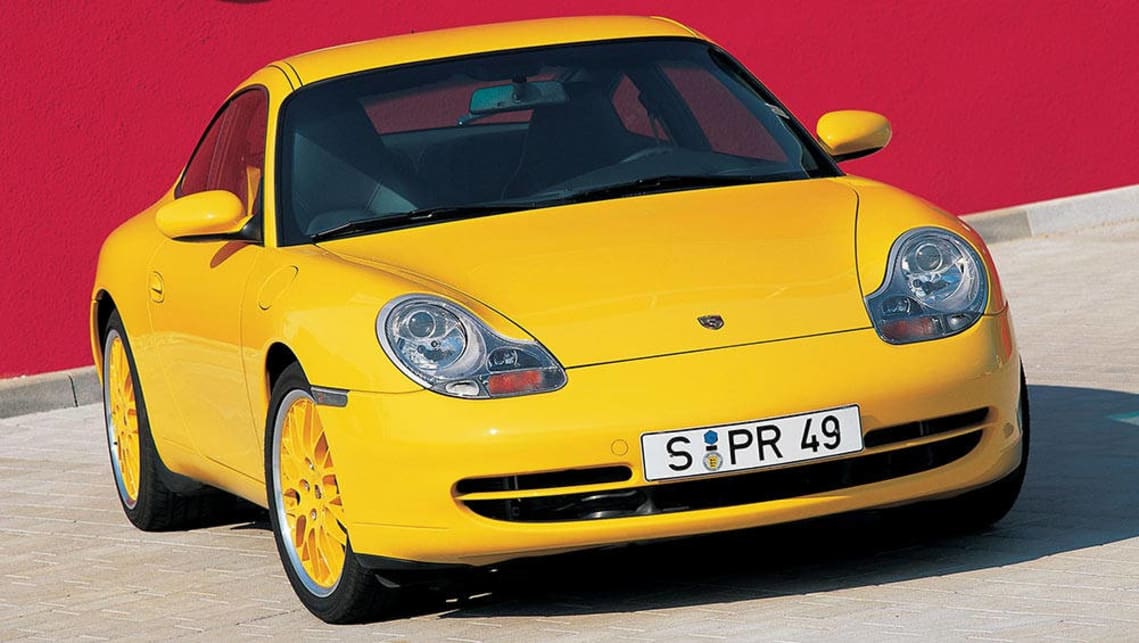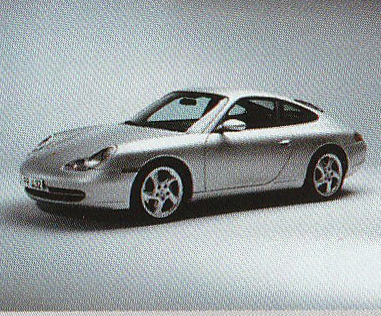
911 Carrera MY 2000
Loosely translated from the original German
.jpg)
Good cylinder filling thanks to four-valve technology and stable thermal conditions thanks to water cooling make the boxer engine effective. With a displacement of 3.4 liters, the power is 221 kW (300 hp). The design of the boxer engine offers decisive advantages for the construction of sports cars. Its mass balance is perfect, its dimensions are compact, and the short and rigid crankshaft allows high speeds.
The drag coefficient of the body of the 911 Carrera is Cw = 0.30, significantly lower than the value of its predecessor, which was 0.34. The product of the value and the frontal area, which has become slightly larger, is also more favorable at 0.58 m². What particularly distinguishes the current 911 is the low lift values. On the front axle, the lift factor is CAV = 0.08, on the rear axle, this value, supported by the extendable spoiler, even reaches CAH = 0.05.
The 911 Carrera guarantees enough space even for passengers of above average height. The driver and front passenger can move the seats far back and enjoy their leg and elbow room. After folding down the rear seat backrests, the storage space behind the front seats in the coupe offers a volume of up to 200 liters.
The proverbial stability of a Porsche body has been further increased through structural design and the use of high-quality sheet metal that is precisely adapted to the loads. The torsional rigidity of the body is far above the average of comparable sports cars. The strength reserves not only reinforce the impression of quality, but also improve driving behavior. Of course, the stable construction has a positive effect in the event of a crash. The 911 has an extremely robust passenger cell that sets standards.
The design of the 911 takes up the design language of the classic in all essential features. The stylistic elements are subtle and elegant. The fenders are no longer as prominent. The width required by the chassis and tires of a modern high-performance sports car has been harmoniously incorporated into the body. When revising the classic silhouette, the designers also found a starting point for further improvement: the transition from the windshield to the roof is now much smoother. Since the current 911 basically stays on the traditional line of the most successful Porsche, its recognition value is, as practice shows, extraordinarily high.
Streamlined and smoothed across the board, the 911 has good aerodynamics. The drag coefficient fell from 0.34 to 0.30 compared to the previous model. Although the body is wider and the frontal area is larger, the overall air resistance is lower than that of the competition. The lift on the front and rear axles is exemplary low. This is very beneficial for driving safety at high speeds.
The body is spacious in the key areas. The passengers enjoy more elbow room and an overall feeling of spaciousness. The front trunk has a volume of 130 liters, the storage option behind the rear seats has gained 65 liters of additional storage space. With the seats folded down, the load volume here is around 200 liters.
By designing the load-bearing structures and using special, high-strength sheet metal, the engineers have raised the bar for solidity in the 911 body even higher. Torsional and bending stiffness are around 50 percent better. The deformability of the body in the event of an accident is more effective. Crash tests at Porsche have shown that the load on the occupants remains low even in serious collisions. The airbags for the driver and front passenger as well as the side airbags, which are fitted as standard in all Porsche vehicles, also contribute to further increasing passive safety.
With the water-cooled six-cylinder boxer engines, a new chapter in engine construction has begun at Porsche. The 3.4-liter engine produces 221 kW (300 hp) at 6,800 rpm, and the maximum torque is 350 Newton meters at 4,600 rpm. The fuel consumption and pollutant emissions in the exhaust are exemplary. With the help of the Motronic ME 7.2 and new catalytic converter technology used since the last model year, the values even fall below the strict Low Emission Vehicle (LEV) standard in the USA and the EU3 limits that apply in Europe from January 1, 2001. The noise level is also below future limits, but the Porsche sound remains unmistakable.
The six-speed manual transmission and five-speed automatic transmission are designed for the performance characteristics and high torque of the water-cooled boxer engine. The six-speed transmission is compact and lightweight. The Tiptronic S has five speeds and is offered with the option of manual short-term control. This means that the gear can be changed manually using the rocker switches on the steering wheel, even if the selector lever is still in the automatic position.
The chassis enables effortless vehicle control. The rack and pinion steering is in a position in front of the front axle that is advantageous for the steering geometry. The front wheel suspension - based on the McPherson system - has elastically connected cross struts and longitudinal control arms. This allows elastokinematic toe-in control to stabilize the self-steering behavior at the cornering limit. The rear wheels, which are guided by five control arms, also change their toe-in values when cornering and guarantee a slight understeering behavior at the limit. All wheel guide parts and their support elements are made of light metal.

Another aim of the fine-tuning of the chassis was to improve the suspension and ride comfort. The success of these measures is clearly and pleasantly noticeable in the normal chassis tuning. The 911 is more than ever a grand touring car with excellent long-distance suitability. As an alternative, Porsche offers a sports tuning that meets the needs of particularly ambitious drivers. To improve stability, the braking system was fitted with four-piston monobloc brake calipers made of light alloy that were tested at the 24 Hours of Le Mans. This guarantees maximum deceleration and minimal fading. Of course, the braking system includes an anti-lock braking system. Porsche Stability Management (PSM) can also be ordered on request.
In addition to the sporty approach and performance, Porsche also ensures that the demand for comfort is not neglected. For example, all models of the 911 Carrera are equipped as standard with electrically adjustable driver and passenger seat backrests, electric windows, green-tinted heat-insulating glazing and fully automatic air conditioning with integrated activated carbon filter.
A cassette radio with cassette storage is also included as standard. The Porsche CR 22 offers FM, MW and LW reception. A total of 40 station memory locations are available. The display shows the station that is currently tuned as well as the strongest station that can be received. The four power amplifiers each have an output of 30 watts with a 10 percent distortion factor. The cassette player has auto-reverse, track search and Dolby B and C. The CR 22 cassette radio is acoustically tuned to the installed loudspeakers and the room conditions in the car and has automatic speed-dependent volume control. A telephone input enables the installation of a hands-free system without additional loudspeakers, whereby the volume is also adjusted via the radio.
The interior is further enhanced by plastic parts painted with soft varnish in the interior color and additional equipment details in an aluminum look, such as the side airbag symbol and the insert in the gear lever. The 911 coupé models also have an Alcantara roof liner.
.jpg)
.jpg)
.jpg)
.jpg)

911 Carrera MY 2000

911 Carrera MY 2002

Porsche Press kit

Porsche Literature

Our Porsche Cars